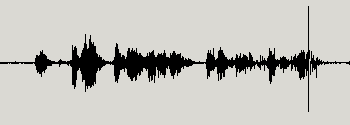
Allan Kaprow ; The Banff Centre, Canada; 29/2/91
Kaprow (1927-2006) is best known for his 'Happenings', performance based events often involving other participants and often taking place outside of gallery contexts, of the 1960's and 70's; and for his influence on Fluxus and Performance art. In this lecture he outlined his self-conception as a 'life-like artist'(meaning that his work was rooted in the actions, materials and situations of the everyday). Starting with his interest in Jackson Pollock and Butai action painting, he defined his practice as embodying a particular mode of 'paying attention', demonstrating this by involving the audience in a ten minute variant of one of his earliest Happenings, developed in 1957 whilst he was studying under John Cage at the New School for Social Research in New York.
During the course of the lecture he described other Happenings, including 'Fluids' (1967) which involved the positioning and melting of large blocks of ice; and 'Burbank' (1972) where participants exchanged and supplanted leafy and non leafy twigs and branches between trees, also using artificial leaves, and photographed the results. This piece referenced the work of John Burbank who was an early pioneer in genetic engineering.
Kaprow traces the swell of interest in Performance art through the increasing scale and complexity of his and others' works, until a drop in optimism in the late 1960s reversed the trend towards smaller, more intimate and introverted pieces which in his work he called simply 'Activities'. He contextualises this within societal attitudes and events, and reflects upon the development of his own practice as part of his life's pattern. This lecture is very revealing of Kaprow's working methods and thought processes, and about how the interpretations, improvisations and responses of participants and observers activated and changed his work.
